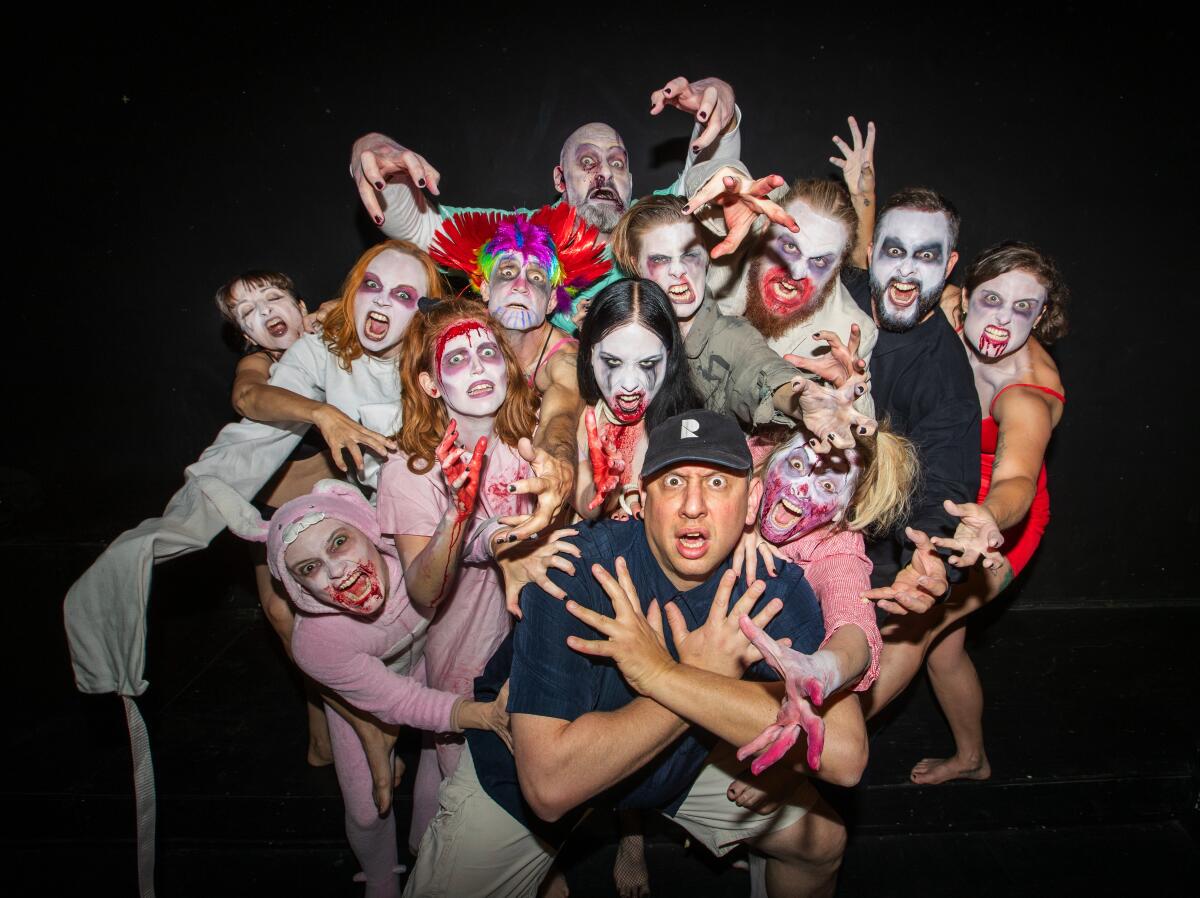Newsletter: Essential Arts: How rent increases threaten a longtime art colony in downtown L.A.

- Share via
The future of an important L.A. art colony and the controversial biennial in the (Saudi) desert. I’m Carolina A. Miranda, staff writer at the Los Angeles Times, with your guide to the week’s essential arts news ... and terrible dancing videos.
The end of an art colony?
For 30 years, an old furniture factory in downtown L.A. has been an important haven for artists. But the inhabitants of the Santa Fe Art Colony, first established by the Community Redevelopment Agency, are facing devastating rent increases now that the property has been deregulated. Contributor Matt Stromberg reports on how some of the artists who live in Santa Fe have been fighting to preserve one of downtown’s last artist spaces.

Related: my report from 2017 about how artists are becoming an endangered species in the nearby Arts District.
Desert X’s controversial Saudi show
Times art critic Christopher Knight has a blazing commentary on why Desert X’s decision to stage its next biennial in Saudi Arabia is “the beginning of the end for a once-promising art event.” The show, he notes, serves to puff up an absolute monarchy that is responsible for the gruesome death of journalist Jamal Khashoggi. “Saudi Arabia is an absolute monarchy built on theocratic law,” writes Knight. “Free expression is forbidden. Illegal. A criminal act. The modern idea of art is exactly opposite.”

Speaking of international controversies: the Royal Museum for Central Africa opened in Brussels in 1897 to celebrate Belgium‘s colonial conquests in the Congo. A recent $73-million renovation was expected to update paternalistic and outdated displays that glossed over colonial atrocities. That, however, hasn’t quite happened. “For me, seeing the amount of money that they put into it, but to think that they didn’t actually change a lot, is a bit concerning,” says Aline Nyirahumure, who runs a nearby African cultural center.
In the galleries
L.A. artist Nancy Baker Cahill has organized an augmented reality show that adds a virtual layer of art to contested sites around New Orleans. “Battlegrounds” features work that explores the meaning of sites such as plantations and Confederate statues, all visible through a free phone app. “I’ve been thinking a lot about our current moment, how it feels like a cultural civil war,” Baker Cahill tells The Times’ Deborah Vankin. “It felt urgent to wade into the literal swamp of these difficult conversations.”
Ardeshir Tabrizi has a new show of mixed media paintings at Roberts Projects that feature multiple layers of images and figures drawn from Persian myth. These embody a sense of “temporal dislocation,” writes contributor David Pagel. “They give form to the fractured reality people inhabit when the present is out of sync with everything that came before it.”
Pagel also reviews Phillip K. Smith‘s “10 Columns” at Bridge Projects, which transforms a new 7,000-square-foot gallery into a synthetic sunrise and sunset. (“Pick a spot, sit down and be bathed in the supercharged rainbow,” he suggests.) He also checks out a show at Nonaka-Hill that surveys the work of the late Tatsumi Hijikata, an artist who “transformed modern Japanese dance into a kind of performance art so primal and poetic that it still resonates today.”
Contributor Scarlet Cheng profiles James Griffith, a painter whose primary material is tar drawn from the La Brea Tar Pits. To his paintings of animals and celestial bodies (now on view at Craig Krull in Santa Monica), “this primordial goo,” he tells her, adds “this other dimension.”
On the stage
A new adaptation of “Jesus Christ Superstar” is at the Hollywood Pantages through Sunday and Times theater critic Charles McNulty is on it. The production “struts across the stage like a rocker in search of an available amphitheater,” he writes. “Hoodies and screeching are in, clear enunciation of lyrics and cogent storytelling are out.” Queue the scraping record sound.
McNulty also reviews “Aubergine,” Julia Cho‘s drama about a chef who is taking care of his dying father. “Food isn’t just food,” he writes of the play’s gustatory themes. “It’s a language of love — and therefore also a language of loss.”
Jeton Nezirag‘s “Department of Dreams,” a dystopian tale about a society that forces its citizens to “deposit” their dreams with a government bureaucracy, is having its world premiere at the City Garage in Santa Monica. And it is a “surreal” and “wildly imaginative” work, reports contributor F. Kathleen Foley.
Philip Brandes reports on a “lively, deeply moving revival” of “Big River: The Adventures of Huckleberry Finn,” the musical adaptation of Mark Twain‘s century-old tale, that is currently on view at the Rubicon Theatre in Ventura. It is a production, he writes, “that emphasizes intimacy over spectacle.”
Violence. Nudity. Graphic depictions of rape, suicide and addition. Those are some of the difficult topics tackled by Zombie Joe’s Underground Theatre Group in its annual Halloween production “Urban Death: Tour of Terror.” And it’s not for the faint of heart, reports The Times’ Makeda Easter.

“Ravenswood Manor” is a “camp horror soap opera” that unfolds in 12 parts at the Celebration Theatre in West Hollywood. It is, writes Nikki Munoz, “a sharply written and well-acted exemplar of the horror-comedy genre.”
Classical notes
The three surviving past and present musical directors of the LA Phil — Zubin Mehta, Esa-Pekka Salonen and Gustavo Dudamel — were united onstage last weekend for the Philharmonic’s 100th birthday gala. Each conductor had a turn at the stand and then shared duties on Daníel Bjarnason‘s “From Space I Saw Earth,” a work for three conductors. Times classical music critical Mark Swed was present, and reports on how each man shaped the orchestra’s sound.
Essential image
Times photographer Wally Skalij, who last year took an unforgettable picture of a sand-covered owl during a fire in Malibu, made an incredible picture during the Easy fire in Simi Valley this week that showed flames advancing on the Reagan Library. He explains how he got the image.

In fire related news: the Getty Center survived the namesake Getty fire. But the fire claimed a midcentury Modern home by Case Study architect Craig Ellwood.
Our graphics and data team has a continuously updated map of California wildfires. Stay safe, everyone.
Ready for the weekend
Margaret Gray has everything doing in small theaters, including the American premiere of “The 7 Stages of Grieving” at the Skylight.
Matt Cooper rounds up his list of the 6 best things to do in L.A., including two Día de los Muertos festivals.
Your support helps us deliver the news on culture — and this newsletter. Subscribe to the Los Angeles Times.
In other news
— At the Marciano Art Foundation, visitor services staff — including docents and gallery attendants — announced a unionization campaign Friday evening.
— A stunt motorcyclist was injured during the first performance of a new $63-million Cirque du Soleil production in Las Vegas.
— How Michael Novak is maintaining the legacy of Paul Taylor American Modern Dance after Taylor’s death.
— Robert Gore Rifkin, a philanthropist known for collecting German Expressionist art, whose donation of 5,000 works on paper helped establish a study center in his name at LACMA, has died at 91.
— Sandra Jackson-Dumont of the Metropolitan Museum of Art has been named the new director of George Lucas’ Museum of Narrative Art.
— That Jeff Koons sculpture of tulips he “gave” to France? The French aren’t exactly loving it.
— A downtown L.A. building decorated by celebrated tilemaker Ernest Batchelder, and long obscured from public view, is for sale.
— You can tour historic homes by Greene & Greene as part Craftsman Weekend in Pasadena this weekend.
— Tickets for Modernism Week in Palm Springs are now on sale.
— How vegans are transforming interior design.
— A brief history of houses built out of spite.
And last but not least ...
Sean Spicer, dancing.
More to Read
The biggest entertainment stories
Get our big stories about Hollywood, film, television, music, arts, culture and more right in your inbox as soon as they publish.
You may occasionally receive promotional content from the Los Angeles Times.











